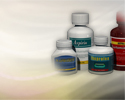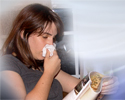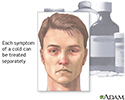How to treat the common cold at home
Upper respiratory infection - home care; URI - home care
Colds are very common. A visit with your health care provider is often not needed, and most colds get better in about a week. Some symptoms, such as runny nose and cough can last 14 days or longer.
A type of germ called a virus causes most colds. There are many types of viruses that can cause a cold. Depending on what virus you have, your symptoms may vary.
Common symptoms of a cold include:
- Fever (100°F [37.7°C] or higher) and chills
- Headache, sore muscles, and fatigue
- Cough
- Nasal symptoms, such as stuffiness, runny nose, yellow or green mucus, and sneezing
- Sore throat
Mild symptoms of COVID-19 may be similar to those of the common cold. Always check with your provider if you are at risk for COVID-19.
Treating Your Cold
Treating your symptoms will not make your cold go away, but it will help you feel better.
Acetaminophen (Tylenol) and ibuprofen (Advil, Motrin) help lower fever and relieve muscle aches. Aspirin can also treat a cold, but it may have potential serious side effects, such as stomach bleeding. So it's best to avoid using aspirin. Aspirin should never be used in children and teens due to the risk of Reye syndrome.
When taking over-the-counter (OTC) pain relievers:
- Check the label for the proper dose.
- Call your provider if you need to take these medicines more than 4 times per day or for more than 2 or 3 days.
OTC cold and cough medicines may help ease symptoms in adults and older children.
- Do not give OTC cough and cold medicine to children under age 4, as they can have serious side effects.
- For children ages 4 to 6 years, contact your provider before giving your child OTC cold medicine.
- If you take prescription medicines for another health problem, ask your provider which OTC cold medicines are safe for you.
Many OTC multi-symptom cough and cold medicines use more than one medicine.
- Instead of buying OTC remedies with multiple medicines, treat each symptom individually. That way you know how much you are taking of each medicine.
- If you do opt for these medicines, be sure to read the labels carefully to make sure you do not take too much of any one medicine.
To treat individual symptoms:
- A nasal decongestant can help relieve stuffiness and a runny nose.
- Throat lozenges or sprays can help ease a sore throat.
- Coughing is your body's way of getting mucus out of your lungs. So only use cough medicines if needed.
- A cough suppressant can help if your cough keeps you from getting enough rest or sleeping at night.
- If you are coughing up thick mucus, a cough expectorant may help. It thins mucus so it's easier to cough it up.
Here are other things you can do to help relieve a cold:
- Drink plenty of water and other fluids without caffeine. You lose a lot of fluid from coughing and blowing your nose, and this will help you stay hydrated.
- Gargle with warm salt water to help relieve a sore throat.
- Prop yourself up with pillows at night to help relieve your cough so you can sleep.
- A humidifier may help ease symptoms. Follow all instructions for cleaning the machine.
- Breathe in steam by taking a hot shower, or putting your head under a towel and over a bowl of hot water.
- Take time to rest and get plenty of sleep.
- Stay away from secondhand smoke.
Drink plenty of fluids, get enough sleep, and stay away from secondhand smoke.
Wheezing can be a common symptom of a cold if you have asthma.
- Use your rescue inhaler as prescribed if you are wheezing.
- See your provider immediately if it becomes hard to breathe.
Do not ask your provider for antibiotics to treat a common cold. Keep in mind that antibiotics kill bacteria. They will not treat a common cold, which is caused by a virus.
Home Remedies
Many home remedies are popular treatments for the common cold. These include vitamin C, zinc supplements, and echinacea.
Although not proven to be helpful, most home remedies are safe for most people.
- Some remedies may cause side effects or allergic reactions.
- Certain remedies may change the way other medicines work.
- Contact your provider before trying any herbs and supplements.
Preventing the Spread of Colds
Wash your hands often. This is the best way to stop the spread of germs.
- Rub soap onto wet hands for 20 seconds. Make sure to get under your fingernails. Dry your hands with a clean towel or air dryer and turn the faucet off with a towel.
- You can also use alcohol-based hand sanitizers with at least 60 percent alcohol. Use a dime sized amount and rub all over your hands until they are dry.
To further prevent colds:
- Stay home when you are sick.
- Cough or sneeze into a tissue or into the crook of your elbow and not into the air.
When to Call the Doctor
Try treating your cold at home first. Call your provider right away, or go to the emergency room, if you have:
- Difficulty breathing
- Sudden chest pain or abdominal pain
- Sudden dizziness
- Acting strangely
- Severe vomiting that does not go away
Also contact your provider if:
- You start acting strangely
- Your symptoms get worse or do not improve after 10 days
References
Barrett B. The common cold. In: Goldman L, Cooney K, eds. Goldman-Cecil Medicine. 27th ed. Philadelphia, PA: Elsevier; 2024:chap 329.
Centers for Disease Control and Prevention webpage. Manage common cold. www.cdc.gov/common-cold/treatment/?CDC_AAref_Val=https://www.cdc.gov/antibiotic-use/colds.html. Updated April 24, 2024. Accessed June 18, 2024.
Cohen YZ. The common cold. In: Bennett JE, Dolin R, Blaser MJ, eds. Mandell, Douglas, and Bennett's Principles and Practice of Infectious Diseases. 9th ed. Philadelphia, PA: Elsevier; 2020:chap 58.
Lopez SMC, Williams JV. The common cold. In: Kliegman RM, St. Geme JW, Blum NJ, Shah SS, Tasker RC, Wilson KM, eds. Nelson Textbook of Pediatrics. 21st ed. Philadelphia, PA: Elsevier; 2020:chap 407.
Tips on buying cold and flu medicines
Animation
The difference between a cold and the flu
Animation
Common cold
Animation
Cold remedies - illustration
Cold remedies
illustration
Tips on buying cold and flu medicines
Animation
The difference between a cold and the flu
Animation
Common cold
Animation
Review Date: 2/2/2023
Reviewed By: Linda J. Vorvick, MD, Clinical Professor, Department of Family Medicine, UW Medicine, School of Medicine, University of Washington, Seattle, WA. Also reviewed by David C. Dugdale, MD, Medical Director, Brenda Conaway, Editorial Director, and the A.D.A.M. Editorial team. Editorial update 03/04/2024.


















